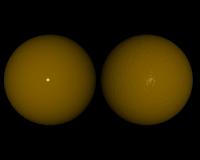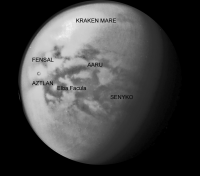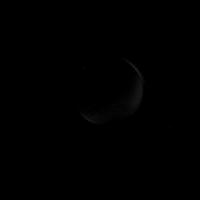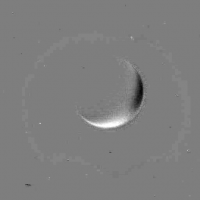Printable Version of Topic
Click here to view this topic in its original format
Unmanned Spaceflight.com _ Titan _ Kraken Mare through polarisers
Posted by: ngunn Mar 29 2009, 08:56 AM
The latest 'looking ahead' gives a nice description of the pi-transfer, introducing the curious concept of a 'rev' that is only half a revolution. It also contains this sentence:
"With Kraken Mare near the field of view, scientists can also use this effort to see how using polarization filters affects the appearance of large bodies of liquid methane on Titan."
Titan followers here may remember why I'm excited about that.
http://www.unmannedspaceflight.com/uploads/post-542-1225378901_thumb.jpg
Posted by: ngunn Apr 3 2009, 03:16 PM
Any news on this?
Posted by: ngunn Aug 27 2009, 11:01 AM
Is it finally time for a third post in this thread?
If I'm not mistaken this image is one of a pair taken with polarisers at 0 and 90 degrees:
http://saturn.jpl.nasa.gov/multimedia/images/raw/casJPGFullS53/W00059373.jpg
I suspect that Kraken Mare is marginally visible between 4 and 5 o'clock in this view. Now the question is: how are the filters oriented with respect to the picture frame? If they're horizontal and vertical that would put the lake at about 45 degrees to both.
If I'm way off with all this somebody please tell me quick!
Posted by: djellison Aug 27 2009, 11:27 AM
If our duck-pond revelation in another thread is true - then a specular reflection is going to be TINY and thus probably unresolvable.
Posted by: ngunn Aug 27 2009, 11:42 AM
I agree, probably, but we won't know for sure without giving it a proper try. I'm not saying either that this was that attempt. Kraken Mare (if seen at all) is way too close to the limb there. BTW Doug, can you answer the question about Cassini's polariser orientations w.r.t. picture frame?
It's just the first time I've noticed a pair of images taken with 90 degree polarisers that may include some wet stuff. Forgive me for getting a little excited.
Posted by: djellison Aug 27 2009, 11:47 AM
Not a clue ![]() There will be a PDF somewhere - and it'll be huge, and on page 1874 - it'll tell you.
There will be a PDF somewhere - and it'll be huge, and on page 1874 - it'll tell you.
Whilst waiting for something else to render, I spat this out just to test the concept myself.
Posted by: remcook Aug 27 2009, 12:34 PM
Page 3 here might be of use for the IRP90 and IRP0 filters (which are the ones that are used http://saturn.jpl.nasa.gov/photos/raw/rawimagedetails/index.cfm?imageID=200189 ):
http://pds-rings.seti.org/cassini/iss/COISS_0011_DOCUMENT/REPORT/iss/5.0/5.1/5.1.8/5.1.8.2_wac_fm.pdf
edit: so I guess horizontal and vertical indeed.
Posted by: ngunn Jun 14 2010, 06:31 PM
Now there's an interesting thing. The latest distant Titan shots include a set of three with polarisers at 0, 60 and120 degrees. This was probably atmospheric study (is that a cloud streak near the centre?) but Kraken Mare was in view just a couple of days ago, so I'm wondering - well you know what I'm wondering.
http://saturn.jpl.nasa.gov/multimedia/images/raw/casJPGFullS60/N00155223.jpg
Posted by: ngunn Dec 21 2010, 03:09 PM
The thread from the dead returns! Three more today: 0, 60 and 120, and I think that's Kraken Mare at lower left. I can't see any obvious differences (but a three way rotating blink would be nice if any image hand fancies the job).
http://saturn.jpl.nasa.gov/multimedia/images/raw/casJPGFullS65/N00165578.jpg
Posted by: volcanopele Dec 21 2010, 05:11 PM
Well, keep in mind that Kraken Mare is in the muck in these views, and that might limit any differences due to the use of different polarizers.
Good though to see the public image site get the real time stream, I wish we did too... ![]() I hope too that this isn't all we got from the Titan observation.
I hope too that this isn't all we got from the Titan observation.
Posted by: titanicrivers Dec 22 2010, 11:01 PM
Looks like some CL1 CB3 filtered images have arrived. Surface features are a bit clearer.
Posted by: ngunn Jun 14 2011, 11:37 AM
Well, here we go again, and this time I think there may be a detectable effect. The images in question are N00172716 (P0 and CB2), N00172717 (P60 and CB2) and N001728 (P120 and CB2). It's my impression that the lake looks slightly darker, and hence more visible, in the P0 image than in the other two. Of course I have no idea whether the polarisation, if present, is happening at the lake suface or higher in the atmosphere.
Anyhow, I have a request which I hope will interest somebody with the necessary image processing skills. I would like to see ratio images with N00172716 and either, or each, of the other two.
Posted by: ngunn Mar 28 2012, 11:18 AM
Another set of three using polarisers with the lake in frame today. Again differences are not immediately obvious but somebody might like to take a closer look and maybe make a blink comparison.
http://saturn.jpl.nasa.gov/photos/raw/rawimagedetails/index.cfm?imageID=256691
http://saturn.jpl.nasa.gov/photos/raw/rawimagedetails/index.cfm?imageID=256690
http://saturn.jpl.nasa.gov/photos/raw/rawimagedetails/index.cfm?imageID=256689
Posted by: ngunn Oct 28 2014, 03:22 PM
Here is another pair through IRP90 and IRP0 this time. The whole northern lake district fits neatly within the illuminated crescent here. Since it's been a while I'll explain again that I'm looking for brightness differences in the lakes caused by specular reflection of the sky (not of the Sun). And again I'm hoping to interest an imaging expert in creating a composite image by subtraction or whatever to see what may pop out. I would expect any differences to be subtle, approximately lake-shaped, and of opposite signs near 3 and 6 o'clock in the image.
Here are the images:
http://saturn.jpl.nasa.gov/multimedia/images/raw/casJPGFullS86/W00090641.jpg
http://saturn.jpl.nasa.gov/multimedia/images/raw/casJPGFullS86/W00090640.jpg
Posted by: algorithm Oct 29 2014, 08:37 PM
Hi,
I don't know if anyone has replied to you via pm but I put the two images that you referred to together and applied a 'subtraction filter ' to it and came up with this.
If it's along the lines of what you were looking for let me know and I may be able to process it further for you, I only used Photoshop so someone with more appropriate software may be able to do more. ![]()
Posted by: ngunn Oct 29 2014, 09:12 PM
On visual inspection I can't say I recognise lake outlines there, but that's not too surprising given that the filters chosen for those images were optimised for atmospheric study rather than for surface features. Also the image orientation was rather unfortunate, putting most of the lake surfaces near 45 degrees from each polariser. But I'm thrilled that somebody has finally had a go at this, so thank you very much!! ![]()
![]() I will continue to look for suitable image pairs for this treatment. (There are a few further up the thread that might be worth a try.)
I will continue to look for suitable image pairs for this treatment. (There are a few further up the thread that might be worth a try.)
I would like to know one thing about the subtraction process you used. Does it preserve the sign of the differences or just their magnitudes? That would greatly affect what I'd be looking for in any future attempts.
Posted by: ngunn Oct 29 2014, 10:17 PM
For anyone puzzled by this off-beat thread here's a short rationale. I'm looking for shiny surfaces. All around you, anywhere, day or night, indooors or out, you have no difficulty identifying shiny surfaces. Some things look matt, others a bit more burnished and others are clearly mirror-like. I'm looking for an image from Cassini that shows the surface of Titan in this way. I want to say to my students "Look, there's a shiny surface. Its obviously wet". The scientists already know its wet and have other priorities so images that serve my purpose will arrive only fortuitously if at all.
Posted by: Greenish Oct 29 2014, 10:56 PM
Here's my take, FWIW:
0. This is useless and invalid if they adjust the contrast on the web jpgs differently for each image. I don't know if this is done for Cassini or not.
1. I registered the images using translation only. I have no idea how much the camera moved or if it rotated between frames, but I assumed the size & orientation were the same between pics. May or may not be accurate.
2. I then converted to floating-point values & subtracted W00090641 from W00090640. I contrast-scaled the result symmetrically about zero. Black shows negative & white positive. Beware blockiness & other compression artifacts in the original JPGs.
Posted by: ngunn Oct 30 2014, 10:01 AM
Positive and negative are distributed as expected there, though the signal is clearly from the atmosphere in this case. That's interesting in itself and a nice demonstration of the method so, again, thanks for giving it a go.
Posted by: ugordan Oct 30 2014, 11:50 AM
It is done. Doing any kind of manipulation that aims to bring out very subtle differences seen through separate filters is a futile effort, IMHO. Raw jpegs are contrast-stretched and clobbered by compression artifacts and loss of dynamic range.
Posted by: nprev Oct 31 2014, 08:42 AM
Incredible mosaic with specular reflection from Kraken Mare:
http://www.jpl.nasa.gov/spaceimages/details.php?id=PIA18432
Posted by: FOV Oct 31 2014, 02:45 PM
I agree nprev, wonderful image(s) of sun glint on Kraken Mare.
Posted by: ngunn Oct 31 2014, 03:35 PM
Spectacular, wonderful, so beautiful in the chosen colour scheme - and definitely shiny!! Words could never do it justice. What a journey we have been on in the few short years since Kraken Mare itself was first glimpsed.
EDIT: From the image caption -This particular sunglint was so bright as to saturate the detector of Cassini's Visual and Infrared Mapping Spectrometer (VIMS) instrument, which captures the view. . . . . Because it was so bright, this glint was visible through the haze at much lower wavelengths than before, down to 1.3 microns.
Reading this makes me wonder if the specular reflection of the sun is so bright that it allows Cassini VIMS to 'see' beyond the normal limits of the methane windows for Titan. A less restricted infrared spectrum could potentially yield a wealth of new information about the atmosphere and maybe the surface too, at least the wet bits.
MOD NOTE: Dedicated thread for this particular image now http://www.unmannedspaceflight.com/index.php?showtopic=7920.
Posted by: ngunn Sep 21 2019, 10:18 AM
Please excuse the old thread revisited but it's been more than a decade since I started enquiring about this topic. I am delighted to see someone taking a proper look at it now.
https://meetingorganizer.copernicus.org/EPSC-DPS2019/EPSC-DPS2019-1900-2.pdf
Powered by Invision Power Board (http://www.invisionboard.com)
© Invision Power Services (http://www.invisionpower.com)




